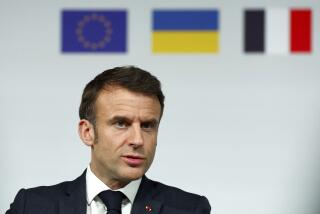Stumbling Toward a Consensus on Bosnia? : Bosnian diplomat breaks the ice with withdrawal proposal
The Western alliance--with Russia as the nervously eyed new member--is in dismaying disarray over the Balkan war. The measure of the disarray is that within the last week the Americans and the Europeans have each adopted a version of each other’s Balkan strategies, and each capitulation has been rejected by the other side. Let us explain.
Broadly, the European view was that the Bosnian conflict could not be resolved but could be contained. Economic sanctions, a blanket arms embargo and patient diplomacy, whatever their limitations, were the best that could be managed under the circumstances. George Bush agreed, but under President Clinton the American view seemed to change: The conflict could not be contained unless it could be resolved, and only military intervention could resolve it.
WHITE PAPER: When Clinton’s call for military intervention was rejected in Europe, he fell back to his own variant of Europe’s containment strategy: a suggestion that U.S. troops be stationed in Macedonia to prevent the spread of the war. But France has now published a white paper proposing that a multinational force, including the United States, enforce the U.N. declaration of five Bosnian towns as “safe areas.” So long as the enforcement troops are not attacked, the paper proposes, there will be no armed engagement in Bosnia. If and when an attack comes, however, it will be answered by air attack. Just a whisker away from full military intervention, the French proposal is close to an earlier American proposal that European ground troops create Bosnian “safe havens” with U.S. air support.
There is, alas, no convergence to be seen. The Macedonians were surprised by the U.S. suggestion (U.N. observers are already stationed in Macedonia), while the Europeans were cold to it. One European counterproposal is that U.S. troops be deployed in Kosovo, the ethnically Albanian province of Serbia. But the Americans are cold to this sudden counter-suggestion as well as to the French white paper.
P.R. PLOY: Meanwhile, the Russians have proposed lifting economic sanctions against Serbia just as those sanctions seem to be taking serious effect. New, tougher sanctions imposed on Serbia-Montenegro April 26 have drastically reduced President Slobodan Milosevic’s access to foreign currency reserves. Milosevic, clearly hurt, has imposed an embargo of his own on the Bosnian Serbs. The embargo is quite possibly a public relations ploy, but Russia’s foreign minister, Andrei Kozyrev, has praised Milosevic as a man of peace and called for the lifting of the sanctions.
In this multiple impasse, if any leader has risked a bold stroke, it may be Bosnian Foreign Minister Haris Siladzic: He has promulgated as official Bosnian policy that the U.N. peacekeepers be removed from his country’s territory. Obviously, what Siladzic believes is that unless there can be a militarily imposed end to the slaughter of the Bosnian Muslims, humanitarian relief is a cruel farce. But his suggestion, if taken, would have two salutary secondary effects. First, the removal would eliminate a serious irritant in the Western alliance by placing European and American forces at equal (and low) risk. Second, the removal could send a deliberately ambiguous signal to the Bosnian Serbs that the way was being cleared for military intervention.
Humanitarian forces might initially be redeployed in Kosovo, Macedonia and the Krajina region of Croatia. Later, if intervention did come, it might indeed best come as the French have suggested. Turning Sarajevo, Bihac, Gorazde, Zepa and Tuzla into militarily guaranteed safe havens need not entail firing a shot or dropping a bomb. It need only halt a slaughter en route to, first, a cease-fire and, later, an open-ended Balkans peace conference that may yet mark the true beginning of the post-Cold War era.
More to Read
Sign up for Essential California
The most important California stories and recommendations in your inbox every morning.
You may occasionally receive promotional content from the Los Angeles Times.










